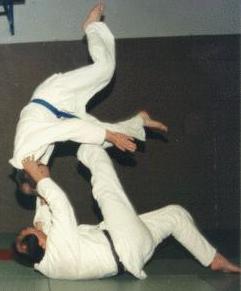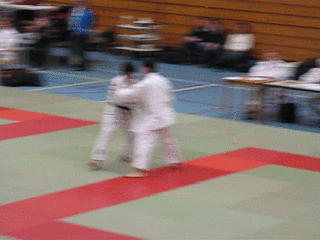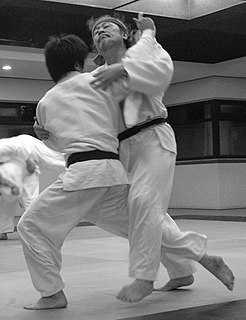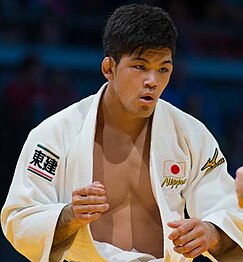
In martial arts, a throw is a grappling technique that involves off-balancing or lifting an opponent, and throwing them to the ground, in Japanese martial arts referred to as nage-waza, 投げ技, "throwing technique". Throws usually involve a rotating motion, the practitioner performing the throw disconnects with the opponent, and ends balanced and on their feet as opposed to a takedown where both finish on the ground. Throws can however also be followed into a top position, in which case the person executing the throw does not disengage from the opponent. Certain throwing techniques called sacrifice throws involve putting oneself in a potentially disadvantageous position, such as on the ground, in order to execute a throw.

Seoi nage (背負い投げ) is a shoulder throw, one of the traditional forty throws of Judo as developed by Jigoro Kano. It belongs to the first group, Dai Ikkyo, of the traditional throwing list, Gokyo, of Kodokan Judo. It is also part of the current 67 Throws of Kodokan Judo. It is classified as a hand technique, te-waza, and is the second throw performed in the Nage-no-kata.

Deashi Harai (出足払), more accurately romanized: Deashibarai, is one of the original 40 throws of Judo as developed by Jigoro Kano. It belongs to the first group, Dai-Ikkyo, of the traditional throwing list, Gokyo-no-Nagewaza, of Kodokan Judo. It is also part of the current 67 Throws of Kodokan Judo. It is classified as a foot technique, Ashi-Waza. Deashi Harai is also one of the 20 techniques in Danzan Ryu's (DZR) Nagete list.

Osotogari (大外刈) is one of the original 40 throws of Judo as developed by Jigoro Kano. It belongs to the first group, Dai Ikkyo, of the traditional throwing list, Gokyo, of Kodokan Judo. It is also included in the current 67 Throws of Kodokan Judo. It is classified as a foot technique, Ashi-Waza.

Ōuchi gari (大内刈)is one of the original 40 throws of Judo as developed by Kanō Jigorō. It belongs to the first group, Dai Ikkyo, of the traditional throwing list, Gokyo, of Kodokan Judo. It is also included in the current 67 Throws of Kodokan Judo.It is classified as a foot technique, Ashi-Waza.
Yama Arashi is one of the preserved throwing techniques, Habukareta Waza, of Judo. It belonged to the fifth group, Dai Gokyo, of the 1895 Gokyo no Waza lists. It is categorized as a hand throwing technique, Te-waza.

Kosoto Gari (小外刈), is one of the original 40 throws of Judo as developed by Jigoro Kano. It belongs to the second group, Dai Nikyo, of the traditional throwing list, Gokyo, of Kodokan Judo. It is also part of the current 67 Throws of Kodokan Judo. It is classified as a foot technique, Ashi-waza. Danzan-ryū's Soto Gama is a variant of Kosoto Gari.

Kouchi Gari (小内刈) is one of the original 40 throws of judo as developed by Jigoro Kano. It belongs to the second group, Dai Nikyo, of the traditional throwing list, Gokyo, of Kodokan judo. It is also part of the current 67 throws of Kodokan judo. It is classified as a foot technique, ashi-waza.

Ashi guruma is a throw in judo. It is one of the original 40 throws of Judo as developed by Kano Jigoro. It belongs to the third group of the traditional throwing list in the Gokyo no waza of the Kodokan Judo. It is also included in the current 67 Throws of Kodokan Judo and is classified as a foot technique (ashiwaza).

Sukui Nage (掬い投) is a double leg takedown, one of the original 40 throws of Judo as developed by Jigoro Kano. It belongs to the fourth group, Yonkyo, of the traditional throwing list, Gokyo, of Kodokan Judo. It is also part of the current 67 Throws of Kodokan Judo. It is classified as a hand technique, Te-waza.

Yoko Guruma (横車), is one of the original 40 throws of judo as developed by Jigoro Kano. It belongs to the fifth group, Gokyo, of the traditional throwing list, Gokyo, of Kodokan Judo. It is also part of the current 67 throws of Kodokan Judo. It is classified as a side sacrifice technique, Yoko-sutemi. This technique is considerably difficult to perform, and can be used as either a direct attack or a counter. In classical study of nage-waza, it is preferable to use it as a counter throw to seoi-nage.

Osoto Otoshi (大外落) is one of the preserved throwing techniques, Habukareta Waza, of Judo. It belonged to the fourth group, Yonkyo, of the 1895 Gokyo no Waza lists. It is categorized as a foot technique, Ashi-waza.
Kouchi Gaeshi (小内返し) is one of the techniques adopted later by the Kodokan into their Shinmeisho No Waza list. The technique is executed by first dodging Uke's Kouchi gari, thereby forcing them off balance, and subsequently throwing Uke to the left or right by twisting their hands. Therefore, it is categorized as a hand technique (Te-waza).
Ouchi Gaeshi (大内返) is one of the techniques adopted later by the Kodokan into their Shinmeisho No Waza list. It is categorized as a foot technique, Ashi-waza. This technique is a reversal, or counter-throw meant to counteract Ouchi gari Judo throw.
Osoto Gaeshi (大外返) is one of the techniques adopted by the Kodokan into their Shinmeisho No Waza list. It is categorized as a foot technique, Ashi-waza. It is essentially a counter throw or reversal for Osoto gari.
Practice of Kaeshi no Kata is almost entirely limited to Great-Britain, where until today it has been understood as a judo kata which, like the Gonosen-no-kata, focuses on counter-attacks to throwing techniques. The kata was commonly explained as being an older form than Gonosen-no-kata, that was passed onto Ōtani Masutarō from Tani Yukio.
The Nage-waza ura-no-kata is a judo kata that, like the Gonosen-no-kata, focuses on counter-attacks to throwing techniques. It was developed by Mifune Kyūzō, and is not an officially recognized Kodokan kata.
Karate's Nage waza is the set of techniques whereby the opponent is thrown to the ground. While typical students of karate focus most of their attention on learning striking techniques, karate throws are considered indispensable for self-defense and, although not always taught, are part of the classical art.

Shohei Ono is a Japanese judoka.














